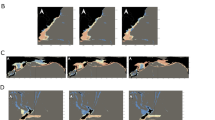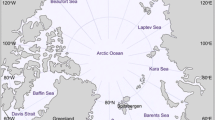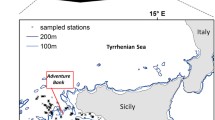Abstract
Our understanding of how environmental change in the Southern Ocean will affect marine diversity, habitats and distribution remain limited. The habitats and distributions of Southern Ocean cephalopods are generally poorly understood, and yet such knowledge is necessary for research and conservation management purposes, as well as for assessing the potential impacts of environmental change. We used net-catch data to develop habitat suitability models for 15 of the most common cephalopods in the Southern Ocean. Using modeled habitat suitability, we assessed favorable areas for each species and examined the relationships between species distribution and environmental parameters. The results compared favorably with the known ecology of these species and with spatial patterns from diet studies of squid predators. The individual habitat suitability models were overlaid to generate a “hotspot” index of species richness, which showed higher numbers of squid species associated with various fronts of the Antarctic circumpolar current. Finally, we reviewed the overall distribution of these species and their importance in the diet of Southern Ocean predators. There is a need for further studies to explore the potential impacts of future climate change on Southern Ocean squid.


















Similar content being viewed by others
References
Arkhipkin AI, Hatfield EMC, Rodhouse PGK. 2013. Doryteuthis gahi, Patagonian long-finned squid. In: Rosa R, Pierce G, O’Dor RK, Eds. Advances in squid biology, ecology and fisheries. Part I—Myopsid squids. New York: Nova Science Publishers. p 123–57.
Ballard G, Jongsomjit D, Veloz SD, Ainley DG. 2012. Coexistence of mesopredators in an intact polar ocean ecosystem: the basis for defining a Ross Sea marine protected area. Biol Conserv 156:72–82.
Boyle P, Rodhouse PG. 2005. Cephalopods ecology and fisheries. Oxford: Blackell Science.
Cherel Y, Duhamel G. 2003. Diet of the squid Moroteuthis ingens (Teuthoidea: Onychoteuthidae) in the upper slope waters of the Kerguelen Islands. Mar Ecol Prog Ser 250:197–203.
Cherel Y, Duhamel G, Gasco N. 2004. Cephalopod fauna of subantarctic islands: new information from predators. Mar Ecol Prog Ser 266:143–56.
Cherel Y, Klages N. 1998. A review of the food of albatrosses. In: Robertson G, Gales R, Eds. Albatross biology and conservation. Chipping Norton: Surrey Beatty & Sons. p 113–36.
Cherel Y, Kooyman GL. 1998. Food of emperor penguins (Aptenodytes forsteri) in the western Ross Sea, Antarctica. Mar Biol 130:335–44.
Cherel Y, Ridoux V, Rodhouse PG. 1996. Fish and squid in the diet of king penguin chicks Aptenodytes patagonicus during winter at sub-Antarctic Crozet Islands. Mar Biol 126:559–70.
Cherel Y, Weimerskirch H. 1999. Spawning cycle of onychoteuthid squids in the southern Indian Ocean: new information from seabird predators. Mar Ecol Prog Ser 188:93–104.
Clarke M. 1980. Cephalopoda in the diet of sperm whales of the southern hemisphere and their bearing on sperm whale biology. Discov Rep 37:1–324.
Collins MA, Allcock AL, Belchier M. 2004. Cephalopods of the South Georgia slope. J Mar Biol Assoc UK 84:415–19.
Collins MA, Rodhouse PGK. 2006. Southern ocean cephalopods. Adv Mar Biol 50:191–265.
Constable AJ, Melbourne-Thomas J, Corney SP, Arrigo K, Barbraud C, Barnes D, Bindoff N, Boyd P, Brandt A, Costa DP, Davidson A, Ducklow H, Emmerson L, Fukuchi M, Gutt J, Hindell MA, Hofmann EE, Hosie G, Iida T, Jacob S, Johnston NM, Kawaguchi S, Koubbi P, Lea M-A, Makhado A, Massom R, Meiners K, Meredith M, Murphy E, Nicol S, Richerson K, Riddle MJ, Rintoul SR, Walker Smith W Jr, Southwell C, Stark JS, Sumner M, Swadling K, Takahashi K, Trathan PN, Welsford D, Weimerskirch H, Westwood K, Wienecke B, Wolf-Gladrow D, Wright S, Xavier JC, Ziegler P. 2014. Change in Southern Ocean ecosystems I: How changes in physical habitats directly affect marine biota. Glob Change Biol 20:3004–25.
Croxall JP, Prince PA. 1996. Cephalopods as prey: seabirds. Philos Trans R Soc B 351:1023–43.
De Broyer C, Koubbi P, Griffiths HJ, Raymond B, Udekem d’Acoz CD, Van de Putte AP, Danis B, David B, Grant S, Gutt J, Held C, Hosie G, Huettmann F, Post A, Ropert-Coudert Y. 2014. Biogeographic Atlas of the Southern Ocean. Cambridge: Scientific Committee on Antarctic Research.
Erickson DJI, Hernandez JL, Ginoux P, Gregg WW, McClain C, Christian J. 2003. Atmospheric iron delivery and surface ocean biological activity in the Southern Ocean and Patagonian region. Geophys Res Lett 30:1609.
Feldman GC, McClain CR. 2010. Ocean Color Web & MODIS Aqua Reprocessing. In: Kuring N, Bailey SW editors. Maryland: NASA Goddard Space Flight Center.
Filippova JA, Pakhomov EA. 1994. Young squid in the plankton of Prydz Bay, Antarctica. Antarct Sci 6:171–3.
Garcia HE, Locarnini RA, Boyer TP, Antonov JI. 2010. World Ocean Atlas 2009, dissolved oxygen, apparent oxygen utilization, and oxygen saturation, Vol. 3Washington, DC: U.S. Government Printing Office. pp 1–344.
Green K, Burton HR. 1993. Comparison of the stomach contents of southern elephant seals, Mirounga leonina, at Macquarie and Heard Islands. Mar Mamm Sci 9:10–22.
Griffiths HJ. 2010. Antarctic marine biodiversity: what do we know about the distribution of life in the Southern Ocean? PLoS One 5:e11683.
Hirzel AH, Le Lay G, Helfer V, Randin C, Guisan A. 2006. Evaluating the ability of habitat suitability models to predict species presences. Ecol Model 199:142–52.
Imber MJ. 1992. Cephalopods eaten by wandering albatrosses Diomedea exulans L. breeding at six circumpolar localities. J R Soc N Z 22:243–63.
Kennicutt MCII, Chown SL, Cassano JJ, Liggett D, Massom R, Peck LS, Rintoul SR, Storey JWV, Vaughn DG, Wilson TJ, Sutherland WJ, Allison I, Ayton J, Badhe R, Baeseman J, Barrett PJ, Bell RE, Bertler N, Bo S, Brandt A, Bromwich D, Cary C, Clark MS, Convey P, Costa ES, Cowan D, DeConto R, Dunbar R, Elfring C, Escutia C, Francis J, Fricker HA, Fukuchi M, Gilbert N, Gutt J, Havermans C, Hik D, Hosie G, Jones C, Kim Y, Le Maho Y, Lee S, Leppe M, Leichenkova G, Li X, Lipenkov V, Lochte K, López-Martínez J, Lüdecke C, Lyons WB, Marenssi S, Miller H, Morozova P, Naish T, Nayak S, Ravindra R, Retamales J, Ricci CA, Rogan-Finnemore M, Ropert-Coudert Y, Samah AA, Sanson L, Scambos T, Schloss I, Shiraishia K, Siegert MA, Simões J, Sparrow MD, Storey B, Wall DH, Walsh JC, Wilson G, Winter J-G, Xavier JC, Yang H. 2014. Six priorities for Antarctic science. Nature 512:23–5.
Lu CC, Williams R. 1994. Contribution to the biology of squid in the Prydz Bay region, Antarctica. Antarct Sci 6:223–9.
NIWA. 2014. New Zealand fish and squid distributions from research bottom trawls. Southwestern Pacific OBIS, National Institute of Water and Atmospheric Research (NIWA), Wellington, New Zealand, 486781 records. http://nzobisipt.elasticbeanstalk.com/resource.do?r=obisprovider. Accessed May 8, 2014.
OBIS. 2013. Data from the Ocean Biogeographic Information System. http://www.iobis.org. Accessed Sep 1, 2013.
Pellissier L, Rohr RP, Ndiribe C, Pradervand J-N, Salamin N, Guisan A, Wisz M. 2013. Combining food web and species distribution models for improved community projections. Ecol Evol 3:4572–83.
Pethybridge HR, Nichols PD, Virtue P, Jackson GD. 2013. The foraging ecology of an oceanic squid, Todarodes filippovae: the use of signature lipid profiling to monitor ecosystem change. Deep Sea Res II 95:119–28.
Phillips RA, Croxall JP, Silk JRD, Briggs DR. 2008. Foraging ecology of albatrosses and petrels from South Georgia: two decades of insights from tracking technologies. Aquat Conserv Mar Freshw Ecosyst 17:S6–21.
Phillips SJ, Anderson RP, Schapire RE. 2006. Maximum entropy modeling of species geographic distributions. Ecol Model 190:231–59.
Phillips SJ, Dudík M, Elith J, Graham CH, Lehmann A, Leathwick J, Ferrier S. 2009. Sample selection bias and presence-only distribution models: implications for background and pseudo-absence data. Ecol Appl 19:181–97.
Radosavljevic A, Anderson RP. 2014. Making better MAXENT models of species distributions: complexity, overfitting and evaluation. J Biogeogr 41:629–43.
Raymond B. 2009/2014. The maximum extent of sea ice in the southern hemisphere by day and by winter season. Australian Antarctic Data Centre—CAASM Metadata. https://data.aad.gov.au/aadc/metadata/metadata_redirect.cfm?md=/AMD/AU/sea_ice_extent_winter.
Raymond B. 2012. Polar environmental data layers. Australian Antarctic Data Centre—CAASM Metadata. https://data.aad.gov.au/aadc/metadata/metadata_redirect.cfm?md=/AMD/AU/Polar_Environmental_Data.
Raymond B, Lea M-A, Patterson T, Andrews-Goff V, Sharples R, Charrassin J-B, Cottin M, Emmerson L, Gales N, Gales R, Goldsworthy SD, Harcourt R, Kato A, Kirkwood R, Lawton K, Ropert-Coudert Y, Southwell C, van den Hoff J, Wienecke B, Woehler EJ, Wotherspoon S, Hindell MA. 2014. Important marine habitat off east Antarctica revealed by two decades of multi-species predator tracking. Ecography 38:121–9.
Raymond B, Marshall M, Nevitt GA, Gillies CL, van den Hoff J, Stark JS, Losekoot M, Woehler EJ, Constable AJ. 2011. A Southern Ocean dietary database. Ecology 92:1188.
Raymond B, Shaffer SA, Sokolov S, Woehler EJ, Costa DP, Einoder L, Hindell M, Hosie G, Pinkerton M, Sagar PM. 2010. Shearwater foraging in the Southern Ocean: the roles of prey availability and winds. PLoS One 5:e10960.
Rio MH, Guinehut S, Larnicol G. 2011. New CNES-CLS09 global mean dynamic topography computed from the combination of GRACE data, altimetry, and in situ measurements. J Geophys Res Oceans 116:C07018.
Robertson G, Williams R, Green K, Robertson L. 1994. Diet composition of emperor penguin chicks Aptenodytes forsteri at two Mawson Coast colonies, Antarctica. Ibis 136:19–31.
Rodhouse PG. 1989. Pelagic cephalopods caught by nets during the Antarctic research cruises of the ‘Polarstern’ and ‘Walther Herwig’, 1985–1987. Archiv für Fischerei Wissenschaft 39:111–21.
Rodhouse PG. 1990. Cephalopod fauna of the Scotia Sea at South Georgia: potential for commercial exploitation and possible consequences. In: Kerry KR, Hempel G, Eds. Antarctic ecosystems: ecological change and conservation. Berlin: Springer. p 289–98.
Rodhouse PG. 1997. Precautionary measures for a new Martialia hyadesi (Cephalopoda, Ommastrephidae) fishery in the Scotia Sea: an ecological approach. CCAMLR Sci 4:125–40.
Rodhouse PG. 1998a. Large and meso-scale distribution of the ommastrephid squid Martialia hyadesi in the Southern Ocean: a synthesis of information relevant to fishery forecasting and management. Korean J Polar Res 8:145–54.
Rodhouse PG. 1998b. Todarodes filippovae in the Southern Ocean: an appraisal for exploitation and management. Large pelagic squids. Tokyo: Japan Marine Fishery Resources Research Center. pp 207–15.
Rodhouse PG. 2013. Role of squid in the Southern Ocean pelagic ecosystem and the possible consequences of climate change. Deep Sea Res II 95:129–38.
Rodhouse PG, Piatkowski U. 1995. Fine-scale distribution of juvenile cephalopods in the Scotia Sea and adaptive allometry of the brachial crown. Mar Biol 124:111–17.
Rodhouse PG, Prince PA, Trathan PN, Hatfield EMC, Watkins JL, Bone DG, Murphy EJ, White MG. 1996. Cephalopods and mesoscale oceanography at the Antarctic Polar Front: satellite tracked predators locate pelagic trophic interactions. Mar Ecol Prog Ser 136:37–50.
Rodhouse PG, Xavier JC, Griffiths H. 2014. Southern Ocean squid. In: De Broyer C, Koubbi P, Griffiths H, Danis B, David B, Grant S, Gutt J, Held C, Hosie G, Huettmann F, Post A, Raymond B, Ropert-Coudert Y, Van de Putte A, Eds. The CAML/SCAR-MarBIN biogeographic Atlas of the Southern Ocean. Cambridge: Scientific Committee on Antarctic Research. p 284–9.
Roeleveld MAC. 1998. The status and importance of cephalopod systematics in Southern Africa. S Afr J Mar Sci 20:1–16.
Roper C, Sweeney M, Nauen C. 1984. FAO species catalogue, Cephalopods of the World. An annotated illustrated catalogue of species of interest to fisheries. Washington, DC: FAO Fish Synop. pp 1–227.
Roper CFE. 1969. Systematics and zoogeography of the worldwide bathypelagic squid Bathyteuthis (Cephalopoda: Oegopsida). U.S. National Museum Bulletin, Vol. 291Washington, DC: US National Museum. p 210.
Sarmiento JL, Gruber N, Brzezinski MA, Dunne JP. 2004. High-latitude controls of thermocline nutrients and low latitude biological productivity. Nature 427:56–60.
Smale MJ. 1996. Cephalopods as prey. IV. Fishes. Philos Trans R Soc Lond B 351:1067–81.
Smith WHF, Sandwell DT. 1997. Global seafloor topography from satellite altimetry and ship depth soundings. Science 277:1957–62.
Sokolov S, Rintoul R. 2007. On the relationship between fronts of the Antarctic Circumpolar Current and surface chlorophyll concentrations in the Southern Ocean. J Geophys Res 112:C07030.
Sokolov S, Rintoul SR. 2009. Circumpolar structure and distribution of the Antarctic Circumpolar Current fronts: 1. Mean circumpolar paths. J Geophys Res Oceans 114. doi:10.1029/2008JC005108.
Spreen G, Kaleschke L, Heygster G. 2008. Sea ice remote sensing using AMSR-E 89 GHz channels. J Geophys Res 113:C02S03.
Trübenbach K, Teixeira T, Diniz M, Rosa R. 2013. Hypoxia tolerance and antioxidant defense system of juvenile jumbo squids in oxygen minimum zones. Deep Sea Research Part II. Top Stud Oceanogr 95:209–17.
Turner J, Bindschadler R, Convey P, Di Prisco G, Fahrbach E, Gutt J, Hodgson D, Mayewski P, Summerhayes C. 2009. Antarctic climate change and the environment. Cambridge: Scientific Committee for Antarctic Research.
Voss NA, Nesis KN, Rodhouse PG. 1998. Systematics, biology and biogeography of the family Histioteuthidae (Oegopsida). In: Voss NA, Veechione M, Toll RO, Sweeney MJ, Eds. Systematics and biogeography of cephalopods. Washington, DC: Smithsonian Contribution to Zoology. p 293–373.
Xavier JC. 1997. Distribution of cephalopods in Antarctic, sub-Antarctic and subtropical waters. Faro: Faculdade das Ciencias do Mar e do Ambiente, Universidade do Algarve. p 87.
Xavier JC, Allcock L, Cherel Y, Lipinski MR, Gomes-Pereira JN, Pierce G, Rodhouse PGK, Rosa R, Shea L, Strugnell J, Vidal E, Villanueva R, Ziegler A. 2015. Future challenges in cephalopod research. J Mar Biol Assoc UK 95:999–1015.
Xavier JC, Cherel Y. 2009. Cephalopod beak guide for the Southern Ocean. Cambridge: British Antarctic Survey. p 129.
Xavier JC, Cherel Y, Roberts J, Piatkowski U. 2013. How do cephalopods become available to seabirds: can fish gut contents from tuna fishing vessels be a major food source of deep-dwelling cephalopods? ICES J Mar Sci 70:46–9.
Xavier JC, Croxall JP, Cresswell KA. 2005. Boluses: an effective method to assess the proportions of cephalopods in the diet of albatrosses. Auk 122:1182–90.
Xavier JC, Croxall JP, Reid K. 2003a. Inter-annual variation in the diet of two albatross species breeding at South Georgia: implications for breeding performance. Ibis 145:593–610.
Xavier JC, Croxall JP, Trathan PN, Rodhouse PG. 2003b. Inter-annual variation in the cephalopod component of the diet of wandering albatrosses Diomedea exulans breeding at Bird Island, South Georgia. Mar Biol 142:611–22.
Xavier JC, Geraint GA, Croxall JP. 2006. Determining large scale distribution of pelagic cephalopods, fish and crustaceans in the South Atlantic from wandering albatross (Diomedea exulans) foraging data. Ecography 29:260–72.
Xavier JC, Rodhouse PG, Purves MG, Daw TM, Arata J, Pilling GM. 2002. Distribution of cephalopods recorded in the diet of Patagonian toothfish (Dissostichus eleginoides) around South Georgia. Polar Biol 25:323–30.
Xavier JC, Rodhouse PG, Trathan PN, Wood AG. 1999. A Geographical Information System (GIS) atlas of cephalopod distribution in the Southern Ocean. Antarct Sci 11:61–2.
Xavier JC, Trathan PN, Croxall JP, Wood AG, Podestá GP, Rodhouse PG. 2004. Foraging ecology and interactions with fisheries of wandering albatrosses at South Georgia. Fish Oceanogr 13:324–44.
Xavier JC, Walker K, Elliot G, Cherel Y, Thompson D. 2014. Cephalopod fauna of South Pacific waters: new information from breeding New Zealand wandering albatrosses. Mar Ecol Prog Ser 513:131–42.
Xavier JC, Wood AG, Rodhouse PG, Croxall JP. 2007. Interannual variations in cephalopod consumption by albatrosses at South Georgia: implications for future commercial exploitation of cephalopods. Mar Freshw Res 58:1136–43.
Acknowledgments
The work was supported by the British Antarctic Survey, under the research programs Long-Term Monitoring of Cephalopod Components in the diets of High Predators—CEPH (within the British Antarctic Survey Ecosystems Program), Australian Antarctic Division, and the Ministry of Science and Higher Education, Portugal (Fundação para a Ciência e a Tecnologia; FCT) with the Scientific Committee for Antarctic Research programs (SCAR) AnT-ERA and SCAR AntECO and Integrating Climate and Ecosystem Dynamics of the Southern Ocean (ICED). This study is part of the British Antarctic Survey Polar Science for Planet Earth (PSPE) Programme. An updated version of the NIWA OBIS data was provided by Kevin Mackay. JX is supported by the Investigator FCT program (IF/00616/2013).
Author information
Authors and Affiliations
Corresponding author
Additional information
Author contributions
Conceived of or designed study—JX, HG, BR. Performed research—JX, HG, BR. Analyzed data—JX, HG, DJ, BR Contributed new methods or models—BR. Wrote the paper—JX, HG, DJ, BR.
Rights and permissions
About this article
Cite this article
Xavier, J.C., Raymond, B., Jones, D.C. et al. Biogeography of Cephalopods in the Southern Ocean Using Habitat Suitability Prediction Models. Ecosystems 19, 220–247 (2016). https://doi.org/10.1007/s10021-015-9926-1
Received:
Accepted:
Published:
Issue Date:
DOI: https://doi.org/10.1007/s10021-015-9926-1




